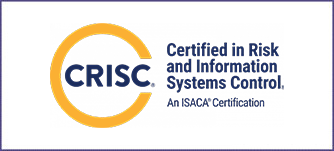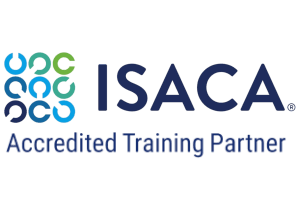SIGN UP TODAY AND GET 20% OFF
CERTIFIED IN RISK AND INFORMATION SYSTEMS CONTROL

OVERVIEW
The CRISC certification prepares IT professionals for enterprise risk management’s unique challenges. The training program enables them to become strategic partners to the enterprise. CRISC is the most current and rigorous assessment available to evaluate IT professionals’ risk management proficiency and other employees within an enterprise or financial institute. CRISC holders help enterprises understand business risks and have the technical knowledge to implement appropriate IS controls.
Risk management is a big thing these days, considering the proliferation of cybercrimes, especially in terms of data theft and fraud. With more of our personal and professional lives moving to the digital world, cybersecurity has become a top priority, especially for businesses. After all, a significant data breach could result in substantial financial losses or even bankruptcy for a company. A business that’s unable to keep its transactions secure gains a reputation for being untrustworthy and risky, which could cause irreversible damage.
Professionals certified in CRISC create a greater understanding of information technology risks and how they impact an entire organization. Furthermore, they devise plans and strategies for mitigating those risks. Finally, CRISC professionals establish a common language to facilitate communication and understanding between the IT groups and stakeholders.
COURSE BENEFITS
FOR INDIVIDUALS
Benefits include:
- Evaluate threats, vulnerabilities and risk to identify IT risk scenarios.
- Establish accountability by assigning and validating appropriate levels of risk and control ownership.
- Establish and maintain the IT risk register and incorporate it into the enterprise-wide risk profile.
- Facilitate the identification of risk appetite and risk tolerance by key stakeholders.
- Promote a risk-aware culture by contributing to the development and implementation of security awareness training.
- Conduct a risk assessment by analyzing IT risk scenarios and determining their likelihood and impact.
FOR ORGANISATIONS
Benefits include:
- Is a tangible indicator of your knowledge and expertise as a risk professional, and shows that you’ve passed your CRISC training
- Increases value for any company or organization that wants to manage IT risk effectively
- Grants a competitive edge over other candidates who are applying for a position or are seeking a promotion
- Grants access to the ISACA global community of knowledge, including the most current ideas regarding IT risk management
- Helps gain and maintain a high standard of professional conduct via ISACA’s requirements for continuing education and ethics
COURSE AND EXAM
-
- GOVERNANCE
- IT RISK ASSESSMENT
- RISK RESPONSE AND REPORTING
- INFORMATION TECHNOLOGY AND SECURITY
- SUPPORTING TASKS:
o Collect and review existing information regarding the organization’s business and IT environments.
o Identify potential or realized impacts of IT risk to the organization’s business objectives and operations.
o Identify threats and vulnerabilities to the organization’s people, processes and technology.
o Evaluate threats, vulnerabilities and risk to identify IT risk scenarios.
o Establish accountability by assigning and validating appropriate levels of risk and control ownership.
o Establish and maintain the IT risk register and incorporate it into the enterprise-wide risk profile.
o Facilitate the identification of risk appetite and risk tolerance by key stakeholders.
o Promote a risk-aware culture by contributing to the development and implementation of security awareness training.
o Conduct a risk assessment by analyzing IT risk scenarios and determining their likelihood and impact.
o Identify the current state of existing controls and evaluate their effectiveness for IT risk mitigation.
o Review the results of risk analysis and control analysis to assess any gaps between current and desired states of the IT risk environment.
o Facilitate the selection of recommended risk responses by key stakeholders.
o Collaborate with risk owners on the development of risk treatment plans.
o Collaborate with control owners on the selection, design, implementation and maintenance of controls.
o Validate that risk responses have been executed according to risk treatment plans.
o Define and establish key risk indicators (KRIs).
o Monitor and analyze key risk indicators (KRIs).
o Collaborate with control owners on the identification of key performance indicators (KPIs) and key control indicators (KCIs).
o Monitor and analyze key performance indicators (KPIs) and key control indicators (KCIs).
o Review the results of control assessments to determine the effectiveness and maturity of the control environment.
o Report relevant risk and control information to applicable stakeholders to facilitate risk-based decision-making.
o Evaluate alignment of business practices with risk management and information security frameworks and standards.
- 4-day training
- Multiple choice examination questions
- 150 questions
- 450 marks (on a scale of 200-800) required to pass
- 240 minutes’ duration
- Closed book
We offer the following learning alternatives:
- 4-day weekly and weekend classroom courses
- 4-day virtual tutor-led weekly and weekend courses
- 4-day corporate on-site courses
COURSE FEE INCLUDES
- Official Course Manual
- Accredited Course Materials
- Accredited trainer with a minimum of ten years industry experience for virtual and classroom courses
- 365 days exam vouchers for our self-paced online, virtual and classroom courses
VAT will be added at the standard rate to the course fee.
TRY A SAMPLE EXAM?
Do visit our Exam Centre to try out sample questions
COURSE BLOGS
You should find our course blogs highly informative.
OVERVIEW
The CRISC certification prepares IT professionals for enterprise risk management’s unique challenges. The training program enables them to become strategic partners to the enterprise. CRISC is the most current and rigorous assessment available to evaluate IT professionals’ risk management proficiency and other employees within an enterprise or financial institute. CRISC holders help enterprises understand business risks and have the technical knowledge to implement appropriate IS controls.
Risk management is a big thing these days, considering the proliferation of cybercrimes, especially in terms of data theft and fraud. With more of our personal and professional lives moving to the digital world, cybersecurity has become a top priority, especially for businesses. After all, a significant data breach could result in substantial financial losses or even bankruptcy for a company. A business that’s unable to keep its transactions secure gains a reputation for being untrustworthy and risky, which could cause irreversible damage.
Professionals certified in CRISC create a greater understanding of information technology risks and how they impact an entire organization. Furthermore, they devise plans and strategies for mitigating those risks. Finally, CRISC professionals establish a common language to facilitate communication and understanding between the IT groups and stakeholders.
COURSE BENEFITS
FOR INDIVIDUALS
Benefits include:
- Evaluate threats, vulnerabilities and risk to identify IT risk scenarios.
- Establish accountability by assigning and validating appropriate levels of risk and control ownership.
- Establish and maintain the IT risk register and incorporate it into the enterprise-wide risk profile.
- Facilitate the identification of risk appetite and risk tolerance by key stakeholders.
- Promote a risk-aware culture by contributing to the development and implementation of security awareness training.
- Conduct a risk assessment by analyzing IT risk scenarios and determining their likelihood and impact.
FOR ORGANISATIONS
Benefits include:
- Is a tangible indicator of your knowledge and expertise as a risk professional, and shows that you’ve passed your CRISC training
- Increases value for any company or organization that wants to manage IT risk effectively
- Grants a competitive edge over other candidates who are applying for a position or are seeking a promotion
- Grants access to the ISACA global community of knowledge, including the most current ideas regarding IT risk management
- Helps gain and maintain a high standard of professional conduct via ISACA’s requirements for continuing education and ethics
COURSE AND EXAM
-
- GOVERNANCE
- IT RISK ASSESSMENT
- RISK RESPONSE AND REPORTING
- INFORMATION TECHNOLOGY AND SECURITY
- SUPPORTING TASKS:
o Collect and review existing information regarding the organization’s business and IT environments.
o Identify potential or realized impacts of IT risk to the organization’s business objectives and operations.
o Identify threats and vulnerabilities to the organization’s people, processes and technology.
o Evaluate threats, vulnerabilities and risk to identify IT risk scenarios.
o Establish accountability by assigning and validating appropriate levels of risk and control ownership.
o Establish and maintain the IT risk register and incorporate it into the enterprise-wide risk profile.
o Facilitate the identification of risk appetite and risk tolerance by key stakeholders.
o Promote a risk-aware culture by contributing to the development and implementation of security awareness training.
o Conduct a risk assessment by analyzing IT risk scenarios and determining their likelihood and impact.
o Identify the current state of existing controls and evaluate their effectiveness for IT risk mitigation.
o Review the results of risk analysis and control analysis to assess any gaps between current and desired states of the IT risk environment.
o Facilitate the selection of recommended risk responses by key stakeholders.
o Collaborate with risk owners on the development of risk treatment plans.
o Collaborate with control owners on the selection, design, implementation and maintenance of controls.
o Validate that risk responses have been executed according to risk treatment plans.
o Define and establish key risk indicators (KRIs).
o Monitor and analyze key risk indicators (KRIs).
o Collaborate with control owners on the identification of key performance indicators (KPIs) and key control indicators (KCIs).
o Monitor and analyze key performance indicators (KPIs) and key control indicators (KCIs).
o Review the results of control assessments to determine the effectiveness and maturity of the control environment.
o Report relevant risk and control information to applicable stakeholders to facilitate risk-based decision-making.
o Evaluate alignment of business practices with risk management and information security frameworks and standards.
- 4-day training
- Multiple choice examination questions
- 150 questions
- 450 marks (on a scale of 200-800) required to pass
- 240 minutes’ duration
- Closed book
We offer the following learning alternatives:
- 4-day weekly and weekend classroom courses
- 4-day virtual tutor-led weekly and weekend courses
- 4-day corporate on-site courses
COURSE FEE INCLUDES
- Official Course Manual
- Accredited Course Materials
- Accredited trainer with a minimum of ten years industry experience for virtual and classroom courses
- 365 days exam vouchers for our self-paced online, virtual and classroom courses
VAT will be added at the standard rate to the course fee.
TRY A SAMPLE EXAM?
Do visit our Exam Centre to try out sample questions
COURSE BLOGS
You should find our course blogs highly informative.
